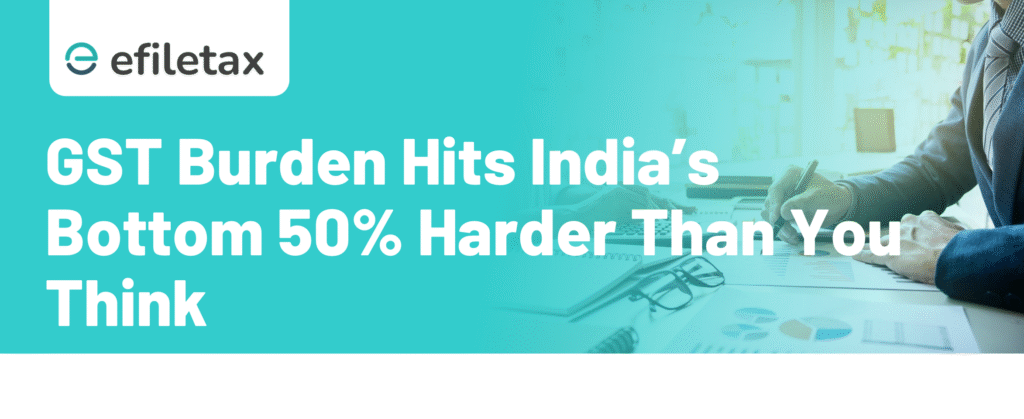
Bottom 50% Bear Undue GST Burden: Study Highlights Urgent Tax Reform Need
A recent study reveals that the bottom 50% bear undue GST burden in India. While GST was introduced as a uniform, consumption-based tax to boost compliance and simplify rates, its regressive nature is now being questioned. The findings call for serious introspection into how GST impacts low-income households compared to the rich.
Key Findings from the Study
Based on a working paper by economists from NIPFP and Azim Premji University (2025):
| Segment | Share of Income | Share of GST Paid | Effective Tax Rate |
|---|---|---|---|
| Bottom 50% | ~15% | ~25% | 10–12% |
| Middle 40% | ~40% | ~50% | 7–9% |
| Top 10% | ~45% | ~25% | 3–5% |
- Disparity: The poorest half pays a higher effective GST rate than the richest 10%.
- Regressiveness: GST hits essential consumption — which forms a major part of poor households’ expenditure.
- Luxury Escape: High-end services and investments attract little or no GST.
Why the Bottom 50% Pay More
The bottom 50% bear undue GST burden because:
- GST is a consumption tax – Poor households spend most of their income on taxed essentials.
- Low exemption slab – Only a few food items are tax-free, rest attract 5–18% GST.
- Tax on services – Mobile recharge, transport, school fees, cooking gas – all essential but taxable.
Legal & Policy Perspective
- No income-based differentiation in GST – It’s not a progressive tax like income tax.
- 15th Finance Commission & CAG have raised concerns over GST’s equity.
- Article 14 jurisprudence (equal protection of law) may be tested if burden becomes disproportionately discriminatory.
- CBIC FAQs & GST Council discussions have acknowledged the need for rate rationalisation.
Expert View
Dr. Yamini Aiyar, policy expert, suggests:
“We need a multi-rate GST that protects essentials and shifts the burden to luxury goods and sin items. That’s how equity can be achieved.”
Practical Tip for Low-Income Households
- Track GST on every monthly expense — groceries, cooking gas, mobile, school fees.
- Maintain bills for claim/refund (where eligible via welfare schemes).
- Use public health and education services wherever exempt from GST.
GST Reform: The Way Forward
Reforming GST to reduce the burden on the bottom 50% must include:
- 0% GST on essentials (healthcare, unbranded foods, sanitary pads)
- Higher GST on luxury and non-essential consumption
- Cashback/welfare offsets via DBT for low-income groups
- Rationalisation of rates to 3 tiers: 0%, 8%, and 18%
Why This Matters for You
GST affects every Indian daily. If you’re a small business owner, salaried individual, or consultant — knowing the true burden of GST helps you plan finances better and raise your voice for tax justice.
Related Blog
👉 GST Rate Slabs Explained: 2025 Update
External Source
- CBIC Official GST FAQs
- NIPFP Working Paper 2025 – “GST Incidence in India: A Distributional Perspective”
Summary
A 2025 study finds the bottom 50% of Indian households pay a disproportionately high share of GST, making the tax regressive. Essential items remain taxed, while the rich benefit from untaxed savings and exemptions. The findings demand urgent reform in India’s indirect tax structure.
FAQs
Q1. Why is GST called regressive?
Because it taxes everyone at the same rate, regardless of income. Poorer households spend more of their income on taxed items.
Q2. Can GST burden be reduced for the ?
Yes. Through 0% GST on essentials, targeted subsidies, and rate rationalisation.
Q3. Are luxury items taxed higher under GST?
Yes, luxury goods like high-end cars, jewellery, and hotel stays attract 28% or more with cess.